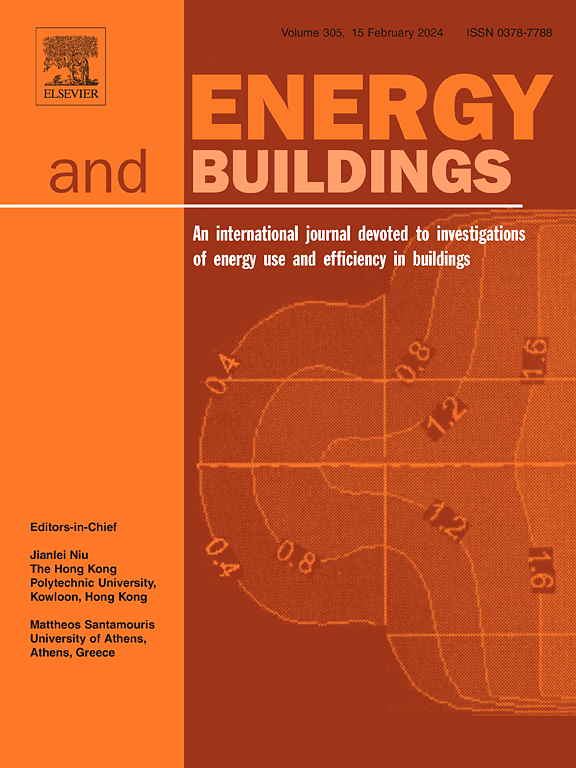Design, manufacturing, and performance of innovative aluminium-backed BIPV facade modules: a case-study in Germany
IF 6.6
2区 工程技术
Q1 CONSTRUCTION & BUILDING TECHNOLOGY
引用次数: 0
Abstract
This paper presents the design, manufacturing, and performance analysis of novel aluminium-backed Building-Integrated Photovoltaic (BIPV) facade modules. A key innovation in the manufacturing process is the integration of a spacer layer that ensures electrical isolation between the aluminium backing and solar cells, maintaining compliance with safety standards. Laboratory characterization revealed a mean power output under Standard Test Conditions (STC) of 35 Wp per module and temperature coefficients of −0.368%/K for power. To account for the variable operating conditions in facade applications, the modules were also tested under different irradiance and temperature levels. Furthermore, their performance was evaluated under various electrical configurations and partial shading scenarios to assess the impact of shading and the effectiveness of mitigation strategies. Series configurations with bypass diodes reduced additional shading losses from 65% to 8% in long side shading scenarios. Parallel configurations demonstrated the highest shading resistance but suffered from reduced power output due to increased currents (increase of I2-resistive losses). Beyond laboratory testing, real-world performance was assessed using a custom-designed substructure that enabled vertical mounting in all cardinal directions (North, East, West, and South), with each orientation represented by a series of four modules (135Wp per orientation). This setup facilitated simultaneous measurement of irradiance, temperature, and I-V curve parameters, allowing for a comprehensive comparison of energy yields across orientations. The results highlight the benefits of not only south-facing facades but also east-, west-, and even north-facing installations. Furthermore, PVSyst simulations incorporating laboratory findings were conducted to estimate annual energy yields across different geographic locations. For the test site in Halle (Saale), the simulated yearly energy yield ranged from 42.4 kWh for the north-facing facade to 107.3 kWh for the south-facing facade, based on the installed capacity of 135 Wp per orientation. Additional simulations for other climatic regions confirmed the general trends, while highlighting variations in absolute yield depending on local irradiation conditions. The findings demonstrate that multi-directional solar harvesting leads to a more balanced distribution of energy generation throughout the day and across seasons. This study underscores the potential of aluminium-backed BIPV facade modules to enhance sustainable energy production in urban environments, showcasing their viability as an efficient and adaptable solution for building-integrated solar applications.
创新铝背BIPV立面模块的设计、制造和性能:德国案例研究
本文介绍了新型铝背建筑集成光伏(BIPV)立面模块的设计、制造和性能分析。制造过程中的一个关键创新是集成了间隔层,确保铝衬底和太阳能电池之间的电气隔离,保持符合安全标准。实验室表征显示,在标准测试条件(STC)下,每个模块的平均输出功率为35 Wp,功率温度系数为- 0.368%/K。为了考虑立面应用的不同操作条件,这些模块还在不同的辐照度和温度水平下进行了测试。此外,在不同的电气配置和部分遮阳方案下,评估了它们的性能,以评估遮阳的影响和缓解策略的有效性。与旁路二极管串联配置减少了额外的遮光损失从65%到8%的长边遮光方案。并联配置显示出最高的遮光电阻,但由于电流增加(i2电阻损耗增加)而导致功率输出降低。除了实验室测试外,还使用定制设计的子结构对实际性能进行了评估,该子结构可以在所有基本方向(北、东、西、南)垂直安装,每个方向由一系列四个模块表示(每个方向135Wp)。这种设置有助于同时测量辐照度、温度和I-V曲线参数,从而可以对不同方向的能量产量进行全面比较。结果不仅突出了朝南立面的好处,而且还突出了朝东、向西甚至朝北的设施的好处。此外,PVSyst模拟结合了实验室研究结果,估算了不同地理位置的年能源产量。在Halle (Saale)的测试场地,基于每个方向135 Wp的装机容量,模拟的年发电量从朝北立面的42.4 kWh到朝南立面的107.3 kWh不等。对其他气候区域的进一步模拟证实了总体趋势,同时强调了绝对产量因当地辐照条件而异的变化。研究结果表明,多向太阳能收集可以在白天和季节之间更平衡地分配能源。这项研究强调了铝背BIPV立面模块在城市环境中增强可持续能源生产的潜力,展示了它们作为建筑集成太阳能应用的高效和适应性解决方案的可行性。
本文章由计算机程序翻译,如有差异,请以英文原文为准。
求助全文
约1分钟内获得全文
求助全文
来源期刊

Energy and Buildings
工程技术-工程:土木
CiteScore
12.70
自引率
11.90%
发文量
863
审稿时长
38 days
期刊介绍:
An international journal devoted to investigations of energy use and efficiency in buildings
Energy and Buildings is an international journal publishing articles with explicit links to energy use in buildings. The aim is to present new research results, and new proven practice aimed at reducing the energy needs of a building and improving indoor environment quality.
 求助内容:
求助内容: 应助结果提醒方式:
应助结果提醒方式:


